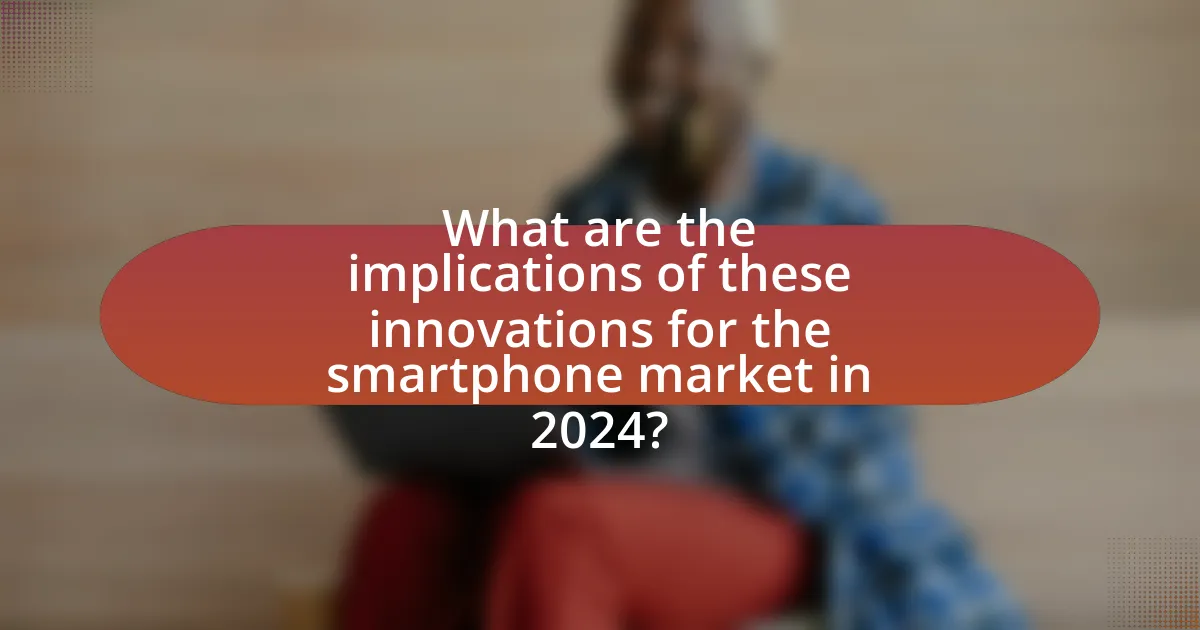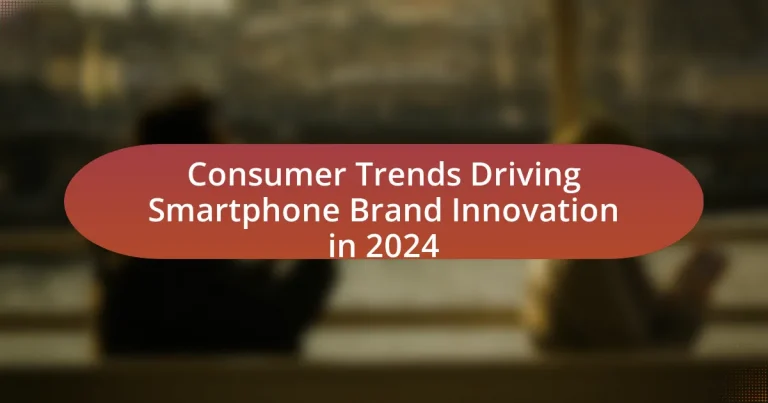The article focuses on consumer trends driving smartphone brand innovation in 2024, highlighting key factors such as sustainability, privacy and security, and advanced AI integration. It discusses how changing consumer preferences are shaping smartphone features, with an emphasis on enhanced camera capabilities, longer battery life, and eco-friendly materials. The article also examines demographic variations in consumer preferences, the importance of sustainability in purchasing decisions, and the impact of technological advancements on user expectations. Additionally, it outlines the challenges brands face in adapting to these trends and the strategies they employ to differentiate themselves in a competitive market.

What are the key consumer trends influencing smartphone brand innovation in 2024?
Key consumer trends influencing smartphone brand innovation in 2024 include a heightened demand for sustainability, increased focus on privacy and security, and the integration of advanced AI features. Consumers are increasingly prioritizing eco-friendly materials and energy-efficient devices, prompting brands to adopt sustainable practices in their manufacturing processes. Additionally, as data breaches become more prevalent, consumers are seeking smartphones that offer robust security features, leading brands to innovate in encryption and biometric technologies. Furthermore, the rise of AI-driven functionalities, such as personalized user experiences and enhanced camera capabilities, is shaping product development, as consumers expect smarter and more intuitive devices. These trends are supported by market research indicating that 70% of consumers consider sustainability when purchasing electronics, while 65% express concerns about data privacy, highlighting the critical areas for innovation in the smartphone industry.
How are changing consumer preferences shaping smartphone features?
Changing consumer preferences are significantly shaping smartphone features by driving demand for enhanced camera capabilities, longer battery life, and improved sustainability. For instance, consumers increasingly prioritize high-quality photography, leading manufacturers to incorporate advanced multi-lens systems and AI-driven enhancements. Additionally, the growing emphasis on battery longevity has prompted brands to develop more efficient power management systems and larger capacity batteries. Furthermore, a shift towards eco-consciousness has resulted in the adoption of sustainable materials and practices in smartphone production, reflecting consumer values. According to a 2023 survey by Deloitte, 62% of consumers consider sustainability a key factor in their purchasing decisions, underscoring the influence of consumer preferences on smartphone innovation.
What specific features are consumers prioritizing in 2024?
In 2024, consumers are prioritizing features such as enhanced battery life, advanced camera capabilities, and improved privacy and security measures in smartphones. Enhanced battery life is crucial as users seek devices that can last longer without frequent charging, reflecting a trend towards more efficient energy consumption. Advanced camera capabilities are increasingly important, with consumers desiring higher resolution, better low-light performance, and innovative features like AI enhancements for photography. Additionally, privacy and security measures are a top concern, with consumers looking for robust encryption, biometric authentication, and transparent data handling practices to protect their personal information. These priorities are shaping smartphone brand innovation as companies strive to meet evolving consumer demands.
How do consumer preferences vary across different demographics?
Consumer preferences vary significantly across different demographics, influenced by factors such as age, income, education, and cultural background. For instance, younger consumers, particularly millennials and Gen Z, tend to prioritize features like camera quality and social media integration in smartphones, while older demographics may focus on usability and battery life. Additionally, income levels affect preferences; higher-income consumers often seek premium brands with advanced technology, while lower-income groups may prioritize affordability and value for money. Research from the Pew Research Center indicates that 85% of adults aged 18-29 own a smartphone, compared to 53% of those aged 65 and older, highlighting the generational divide in smartphone adoption and preferences.
Why is sustainability becoming a critical factor for consumers?
Sustainability is becoming a critical factor for consumers due to increasing awareness of environmental issues and the desire for ethical consumption. Research indicates that 66% of global consumers are willing to pay more for sustainable brands, reflecting a shift in purchasing behavior towards products that minimize environmental impact. This trend is driven by concerns over climate change, resource depletion, and social responsibility, prompting consumers to seek brands that align with their values. As a result, companies that prioritize sustainability in their practices and products are more likely to attract and retain customers in the competitive smartphone market.
What sustainable practices are smartphone brands adopting?
Smartphone brands are adopting sustainable practices such as using recycled materials in device manufacturing, implementing energy-efficient production processes, and promoting device longevity through software updates. For instance, Apple has committed to using 100% recycled aluminum in its products and aims to have a carbon-neutral supply chain by 2030. Samsung has introduced eco-friendly packaging and is increasing the use of recycled plastics in its devices. These initiatives reflect a growing trend among consumers who prioritize sustainability, influencing brands to innovate in environmentally responsible ways.
How does consumer awareness of environmental issues impact brand loyalty?
Consumer awareness of environmental issues significantly enhances brand loyalty. When consumers recognize a brand’s commitment to sustainability and eco-friendly practices, they are more likely to develop a strong emotional connection and preference for that brand. Research indicates that 66% of global consumers are willing to pay more for sustainable brands, demonstrating that environmental consciousness directly influences purchasing decisions. Brands that actively promote their environmental initiatives, such as using recycled materials or reducing carbon footprints, tend to foster greater trust and loyalty among consumers, leading to repeat purchases and positive word-of-mouth.
What role does technology advancement play in consumer expectations?
Technology advancement significantly shapes consumer expectations by driving demand for innovative features and improved user experiences. As technology evolves, consumers increasingly anticipate faster performance, enhanced functionality, and seamless integration across devices. For instance, the rise of 5G technology has led consumers to expect quicker download speeds and more reliable connectivity, influencing their purchasing decisions. Additionally, advancements in artificial intelligence and machine learning have set a standard for personalized experiences, compelling brands to innovate continuously to meet these heightened expectations. This dynamic relationship between technology and consumer expectations underscores the necessity for smartphone brands to adapt and innovate in response to the rapid pace of technological change.
How are emerging technologies influencing smartphone design?
Emerging technologies are significantly influencing smartphone design by enabling features such as foldable displays, advanced camera systems, and enhanced battery life. For instance, the introduction of flexible OLED technology allows manufacturers to create devices with curved or foldable screens, leading to innovative form factors that maximize screen real estate while maintaining portability. Additionally, advancements in artificial intelligence and machine learning are enhancing camera capabilities, allowing for features like improved low-light performance and real-time image processing. Furthermore, developments in battery technology, such as solid-state batteries, promise longer usage times and faster charging, directly impacting user experience and design considerations. These technological advancements are reshaping how smartphones are conceptualized, leading to more versatile and user-centric devices.
What innovations are consumers most excited about in 2024?
In 2024, consumers are most excited about advancements in artificial intelligence integration within smartphones. This includes features such as enhanced voice recognition, personalized user experiences, and improved camera capabilities driven by AI algorithms. According to a survey conducted by Deloitte, 70% of consumers expressed interest in AI-driven functionalities that enhance daily tasks and streamline interactions with their devices. Additionally, innovations in foldable and flexible display technology are generating significant enthusiasm, with 65% of respondents indicating a preference for devices that offer versatility in form factors. These trends reflect a growing demand for smarter, more adaptable technology that aligns with consumer lifestyles.
How do these trends connect to smartphone brand strategies?
Smartphone brand strategies are increasingly aligned with consumer trends such as sustainability, personalization, and advanced technology integration. Brands are adopting eco-friendly materials and practices in response to the growing consumer demand for sustainable products, as evidenced by a 2023 survey indicating that 70% of consumers prefer brands that prioritize environmental responsibility. Additionally, personalization trends drive brands to offer customizable features and user experiences, enhancing customer engagement and loyalty. For instance, companies like Apple and Samsung have introduced software updates that allow users to tailor their devices to individual preferences, reflecting the shift towards personalized technology. Furthermore, the integration of advanced technologies, such as AI and 5G, is a strategic focus for brands aiming to meet consumer expectations for faster, smarter devices, with market research predicting a 25% increase in 5G smartphone adoption by 2024. These connections illustrate how smartphone brands are adapting their strategies to align with evolving consumer preferences and technological advancements.
What challenges do brands face in adapting to these consumer trends?
Brands face significant challenges in adapting to evolving consumer trends, particularly in the smartphone market. One major challenge is the rapid pace of technological advancement, which requires brands to continuously innovate and update their offerings to meet consumer expectations for features such as enhanced camera capabilities, longer battery life, and improved user interfaces. Additionally, brands must navigate shifting consumer preferences towards sustainability and ethical sourcing, which can complicate supply chain management and increase production costs. According to a 2023 report by Deloitte, 60% of consumers prioritize sustainability in their purchasing decisions, indicating that brands must align their practices with these values to remain competitive. Furthermore, the increasing demand for personalized experiences necessitates brands to invest in data analytics and customer relationship management systems, which can strain resources and require significant strategic shifts.

What specific innovations are smartphone brands implementing in response to consumer trends?
Smartphone brands are implementing innovations such as enhanced camera systems, foldable displays, and improved battery technology in response to consumer trends. Enhanced camera systems, including multi-lens setups and AI-driven photography features, cater to the growing demand for high-quality mobile photography. Foldable displays address consumer interest in larger screens while maintaining portability, as seen in devices like Samsung’s Galaxy Z Fold series. Additionally, advancements in battery technology, such as faster charging and longer-lasting batteries, respond to consumer needs for convenience and extended usage. These innovations reflect a direct alignment with consumer preferences for functionality, versatility, and performance in smartphones.
How are brands enhancing user experience through design changes?
Brands are enhancing user experience through design changes by prioritizing user-centric interfaces and streamlined functionalities. For instance, many smartphone manufacturers are adopting minimalistic designs that reduce clutter, making navigation intuitive and efficient. Research indicates that 70% of users prefer simple interfaces, which leads to increased satisfaction and engagement. Additionally, brands are integrating adaptive design elements that personalize user experiences based on individual preferences and usage patterns, further enhancing usability. This approach is supported by studies showing that personalized experiences can increase user retention by up to 30%.
What design elements are most appealing to consumers in 2024?
In 2024, the most appealing design elements to consumers include minimalism, sustainability, and customizable features. Minimalism attracts consumers by providing a clean and uncluttered aesthetic, which aligns with the growing preference for simplicity in technology. Sustainability is increasingly important, with consumers favoring eco-friendly materials and designs that reduce environmental impact, reflecting a broader societal shift towards responsible consumption. Customizable features allow users to personalize their devices, enhancing user engagement and satisfaction. According to a survey by Deloitte, 70% of consumers prioritize sustainability in their purchasing decisions, underscoring the significance of these design elements in influencing consumer behavior in the smartphone market.
How does user interface design impact consumer satisfaction?
User interface design significantly impacts consumer satisfaction by influencing usability, accessibility, and overall user experience. A well-designed interface enhances navigation, reduces cognitive load, and allows users to accomplish tasks efficiently, leading to higher satisfaction levels. Research indicates that 88% of online consumers are less likely to return to a site after a bad experience, highlighting the importance of effective user interface design in retaining customers. Furthermore, studies show that intuitive interfaces can increase user engagement and loyalty, as users are more likely to recommend products that provide a seamless experience.
What advancements in camera technology are brands focusing on?
Brands are focusing on advancements in camera technology such as improved sensor capabilities, computational photography, and enhanced optical zoom features. These innovations aim to deliver higher image quality, better low-light performance, and more versatile shooting options. For instance, the integration of larger sensors allows for greater light capture, while computational photography techniques, like HDR and AI enhancements, improve image processing and detail. Additionally, advancements in optical zoom technology enable smartphones to achieve higher magnification without sacrificing image clarity, as seen in models featuring periscope lenses. These trends reflect consumer demand for professional-grade photography experiences in smartphones.
How do camera features influence purchasing decisions?
Camera features significantly influence purchasing decisions by directly impacting consumer perceptions of quality and functionality. For instance, a study by the Consumer Technology Association found that 70% of consumers prioritize camera quality when selecting a smartphone, indicating that features such as megapixel count, optical zoom, and low-light performance are critical factors. Additionally, advancements in camera technology, such as AI enhancements and multiple lens systems, create a perception of superior value, further driving consumer interest and choice. This correlation between camera features and purchasing behavior underscores the importance of innovation in smartphone design to meet consumer demands in 2024.
What are the latest trends in smartphone photography?
The latest trends in smartphone photography include the integration of advanced computational photography, enhanced low-light performance, and the use of AI-driven features for image processing. Computational photography allows smartphones to capture high-quality images by combining multiple exposures and utilizing algorithms to enhance details and colors. For instance, smartphones like the iPhone 14 and Google Pixel 7 have showcased significant improvements in low-light photography, enabling users to take clearer and more vibrant photos in challenging lighting conditions. Additionally, AI features such as scene recognition and automatic adjustments are becoming standard, allowing for more intuitive and user-friendly photography experiences. These trends reflect the ongoing consumer demand for higher-quality images and innovative features in smartphone photography.
How are brands integrating AI and machine learning into smartphones?
Brands are integrating AI and machine learning into smartphones by enhancing features such as camera capabilities, battery management, and user experience personalization. For instance, companies like Apple and Google utilize machine learning algorithms to improve image processing, enabling features like Night Mode and real-time photo enhancements. Additionally, AI-driven battery optimization algorithms analyze user habits to extend battery life, as seen in devices like the Samsung Galaxy series. Furthermore, brands are employing AI for voice recognition and virtual assistants, improving user interaction and accessibility. These integrations reflect a broader trend where 85% of smartphone users prioritize AI features, indicating a significant consumer demand for smarter devices.
What benefits do consumers expect from AI features?
Consumers expect AI features to enhance personalization, improve efficiency, and provide better decision-making support. Personalization allows for tailored experiences, such as customized recommendations based on user behavior, which can increase user satisfaction. Efficiency is achieved through automation of routine tasks, enabling users to save time and effort. Additionally, AI features assist in decision-making by analyzing data and providing insights, which can lead to more informed choices. According to a 2023 survey by Deloitte, 62% of consumers indicated that they value personalized experiences driven by AI, highlighting the demand for these benefits in smartphone innovations.
How does AI enhance personalization in smartphones?
AI enhances personalization in smartphones by analyzing user behavior and preferences to tailor experiences and recommendations. For instance, machine learning algorithms process data from user interactions, such as app usage and browsing history, to suggest relevant content, optimize settings, and improve user interfaces. According to a report by Deloitte, 80% of consumers are more likely to make a purchase when brands offer personalized experiences, demonstrating the effectiveness of AI-driven personalization in enhancing user satisfaction and engagement.

What are the implications of these innovations for the smartphone market in 2024?
The implications of innovations for the smartphone market in 2024 include increased competition, enhanced user experiences, and a shift towards sustainability. As brands adopt advanced technologies such as AI integration and 5G capabilities, they will differentiate their products, leading to a more competitive landscape. For instance, the introduction of foldable screens and improved camera systems will cater to consumer demand for versatility and high-quality photography, driving sales. Additionally, the growing emphasis on eco-friendly materials and energy-efficient designs reflects consumer preferences for sustainability, influencing purchasing decisions. According to a 2023 survey by Deloitte, 70% of consumers prioritize sustainability in their buying choices, indicating that brands focusing on these innovations will likely capture a larger market share in 2024.
How will consumer trends affect market competition among smartphone brands?
Consumer trends will significantly intensify market competition among smartphone brands by driving innovation and differentiation. As consumers increasingly prioritize features such as sustainability, camera quality, and user experience, brands must adapt to meet these evolving preferences. For instance, a 2023 survey by Deloitte found that 60% of consumers are willing to pay more for eco-friendly products, prompting brands to invest in sustainable materials and practices. Additionally, the demand for advanced camera technology has led companies like Apple and Samsung to enhance their offerings, resulting in a competitive landscape where brands must continuously innovate to attract and retain customers.
What strategies are brands using to differentiate themselves?
Brands are using innovative technology integration, personalized customer experiences, and sustainable practices to differentiate themselves. For instance, smartphone brands are increasingly incorporating advanced features like AI-driven photography and 5G capabilities, which enhance user experience and set them apart in a competitive market. Additionally, brands are leveraging data analytics to offer personalized marketing and product recommendations, fostering stronger customer loyalty. A notable example is Apple’s focus on privacy features, which appeals to consumers increasingly concerned about data security. Furthermore, sustainability initiatives, such as using recycled materials and reducing carbon footprints, resonate with environmentally conscious consumers, as seen in brands like Samsung and their eco-friendly packaging efforts. These strategies collectively enable brands to carve out unique identities and maintain relevance in the rapidly evolving smartphone market.
How do consumer trends influence pricing strategies?
Consumer trends significantly influence pricing strategies by dictating how brands position their products in the market. For instance, as consumers increasingly prioritize sustainability, brands may adopt premium pricing for eco-friendly products to reflect their value. Additionally, data from the 2023 Consumer Electronics Show indicated that 70% of consumers are willing to pay more for innovative features, prompting brands to adjust their pricing to capture this willingness. This alignment between consumer preferences and pricing not only enhances perceived value but also drives competitive differentiation in the smartphone market.
What impact will these innovations have on consumer purchasing behavior?
Innovations in smartphone technology will significantly influence consumer purchasing behavior by increasing demand for advanced features and functionalities. As consumers become more aware of innovations such as improved camera systems, enhanced battery life, and AI-driven applications, their expectations for new devices rise. For instance, a survey by Deloitte in 2023 indicated that 70% of consumers prioritize camera quality when purchasing a smartphone, reflecting a direct correlation between innovation and consumer preferences. Additionally, the introduction of 5G technology has led to a shift in purchasing decisions, with 60% of consumers willing to pay a premium for devices that support faster connectivity. This trend demonstrates that innovations not only attract consumer interest but also drive higher spending on smartphones that meet evolving technological standards.
How do consumers perceive value in relation to smartphone innovations?
Consumers perceive value in relation to smartphone innovations primarily through the lens of functionality, quality, and user experience. Innovations that enhance performance, such as improved battery life, advanced camera capabilities, and faster processing speeds, are highly valued as they directly impact daily usability. For instance, a survey by Deloitte in 2023 indicated that 70% of consumers prioritize camera quality when considering a new smartphone, reflecting a direct correlation between innovation and perceived value. Additionally, features that promote convenience, such as 5G connectivity and seamless integration with other devices, further elevate consumer perception of value. This trend highlights that consumers are increasingly looking for smartphones that not only meet their current needs but also anticipate future demands, reinforcing the importance of continuous innovation in the smartphone market.
What factors will drive consumer loyalty in 2024?
Consumer loyalty in 2024 will be driven primarily by personalized experiences, sustainability, and technological innovation. Personalized experiences, such as tailored marketing and customized product offerings, enhance customer satisfaction and engagement, leading to increased loyalty. Sustainability is becoming a critical factor, as consumers increasingly prefer brands that demonstrate environmental responsibility; a 2022 survey indicated that 66% of global consumers are willing to pay more for sustainable brands. Technological innovation, particularly in smartphone features and user experience, will also play a significant role, as consumers seek cutting-edge technology that meets their evolving needs. These factors collectively create a compelling value proposition that fosters long-term consumer loyalty.
What best practices should smartphone brands adopt to align with consumer trends?
Smartphone brands should adopt a consumer-centric approach by prioritizing sustainability, enhancing user experience, and integrating advanced technology. Sustainability is increasingly important, with 70% of consumers willing to pay more for eco-friendly products, indicating a strong market trend towards environmentally responsible practices. Enhancing user experience through intuitive design and personalized features can lead to higher customer satisfaction, as studies show that 86% of buyers are willing to pay more for a better customer experience. Additionally, integrating advanced technologies such as 5G, AI, and improved camera systems aligns with consumer demand for innovation, as 61% of consumers consider technological advancements a key factor in their purchasing decisions. These best practices ensure that smartphone brands remain relevant and competitive in a rapidly evolving market.




